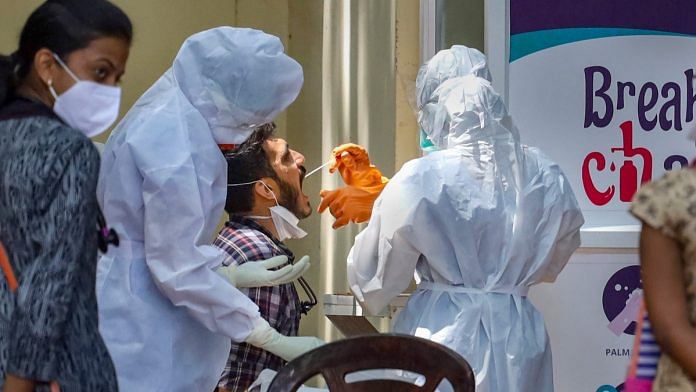New Delhi: Over the past few months since the novel coronavirus pandemic broke out, numerous research groups around the world have claimed to have found candidate drugs or vaccines against the infection using supercomputers or artificial intelligence.
Yet, even as the death toll from Covid-19 continues to rise around the world, the most promising drug candidates are older, repurposed medicines such as remdesivir, which was originally developed to fight Ebola and Hepatitis C.
ThePrint tries to understand why despite the claims of next-generation supercomputers finding drugs against SARS-CoV-2 (virus the causes Covid-19), the findings need to be looked at with a pinch of salt.
Computational biology
Computational biology is a branch of science that attempts to understand and model biological processes using data analytics. The method helps speed up the process of scientific studies, allowing scientists to simulate the biological processes and study them virtually, before investing time and money in laboratory experiments or trials.
Computational biology can help accelerate the process of drug delivery by identifying how a drug molecule will interact with a target pathogen. This method is being used by scientists worldwide to quickly scan through a ‘library’ of thousands of molecules and pick out the ones that are most likely to work against a disease.
“Computational biology can give a first impression of what can inhibit the function of an enzyme (produced by a pathogen), and which of the molecules can be synthesised in the laboratory or procured commercially,” Bichitra K. Biswal, a scientist at the National Institute of Immunology, told ThePrint.
But the journey from this virtual molecule to an actual drug is a long one.
In his most recent work, Biswal showed that Sofosbuvir — a drug currently used to treat Hepatitis C — may inhibit the function of SARS-CoV-2 RNA polymerase that allows the virus to replicate inside cells.
His team also designed new molecules from scratch that they claimed could stop the virus from replicating.
Also read: Antibody from llamas could help block coronavirus entry into cells, say researchers
A long-drawn process
For conducting this research, first scientists need to create a 3D structure of the target enzyme. In this case, it was the RNA polymerase of the Covid-19 virus, which helps the virus to multiply.
“The next thing you need, is a library of compounds. You then take molecules from this library and try to ‘dock’ it with the 3D structure. The docking algorithm tries to find pockets in the 3D structure where these molecules can bind with better ‘binding energy’ — or highest affinity for the molecule,” Biswal explained.
In physics, binding energy describes the energy that would be required to break apart a system of particles. The lower the binding energy, the less stable the bond between two particles.
“By calculating the binding energy of these small molecules with different pockets of the 3D structure, the computer model will identify the ones that are energetically most favourable,” Biswal said.
However, even after the computer system has identified a potential drug candidate, the finding remains a hypothesis, since none of the work so far involves actual drugs or enzymes.
To make these drugs a reality — especially the molecules that have been designed from scratch — researchers need to first synthesise the molecule as well as the target enzyme in order to conduct biochemical assays.
A biochemical assay is a procedure carried out in laboratories to study the binding or activity of a biological molecule.
“If the molecules show good inhibition activity against the enzyme in biochemical assays then it proves the hypothesis,” Biswal explained.
If the biochemical assays show promise, the researchers may further modify the molecule to arrive at the structure that would be most potent. Before a small molecule becomes a drug candidate, it requires a lot of modifications, he said.
“What computational biology does is that it reduces the number of experiments that one needs to do. If we were to start from scratch, we would need to try out thousands of combinations (of drugs and enzymes) in the lab,” Anu Raghunathan, a scientist at CSIR-National Chemical Laboratory, Pune, told ThePrint.
Studies can’t transfer into drugs immediately
Using computational biology to analyse drugs, also known as ‘in silico analysis’, narrows down the candidates to a few hundreds. This also reduces the cost involved in drug discovery since experimental work is very expensive.
However, there is still a high probability that these molecules will not translate into safe and effective medicines. These molecules will need to be tested out first in cell models, then in animal models, and then in three phases of human clinical trials before becoming approved drugs.
But all the data coming out of the computational works are just leads for rigorous studies further, Ranganathan explained.
While in silico analysis to identify drugs work in the larger interest of expanding the body of scientific literature and knowledge, in the middle of an ongoing pandemic it may be too ambitious to expect these studies to immediately translate into viable drugs.
“Broadly speaking, computational aspects are important in pointing experimental science to new possible targets. Algorithms make predictions; but at the end of the day, they have to be tested before any conclusions are drawn,” said Reeteka Sud, a scientist at the National Institute of Mental Health and Neuro-Sciences, Bangalore.
“The drug discovery process is a very long process. Computational biology is one component of the whole process. It is unlikely that one molecule identified through computational biology will eventually become a drug,” Biswal said.
Also read: Trial assessing anti-clotting drug to algorithm guiding PPE use — latest on Covid-19 research






